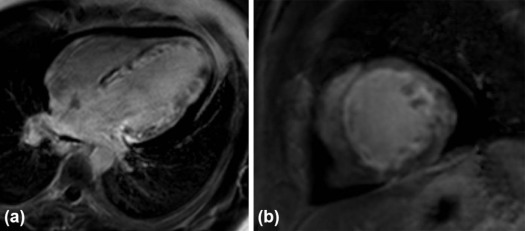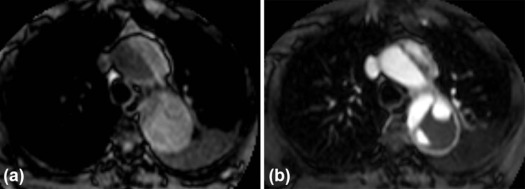Rationale and Objective
The objective of this study was to identify the feasibility and pitfalls of cardiothoracic magnetic resonance imaging (MRI) in intensive care unit (ICU) patients.
Materials and Methods
This retrospective study identified adult ICU patients scheduled for cardiothoracic MRIs during a 10-year study period. ICU patients scheduled for brain MRIs served as a comparison group. A chart review was performed to identify factors impacting a patient’s ability to undergo an MRI. Differences between completed and canceled examinations for both cardiothoracic and brain MRIs were evaluated. For the cardiothoracic group, clinical indications and the diagnostic value of the study performed were also identified.
Results
A total of 143 cardiothoracic MRIs and 1011 brain MRIs were requested. Cardiothoracic MRI patients were less frequently completed (52% vs 62%), more frequently men (64% vs 43%), younger (55 vs 63 years), less likely mechanically ventilated (8% vs 29%), more likely to require intravenous contrast (83% vs 23%), and had longer examination times compared to brain MRI patients (64 vs 21 minutes). Successful completion of cardiothoracic MRI was associated with lower serum creatinine, higher glomerular filtration rate, and the absence of mechanical ventilation; significant differences were not seen with regard to gender and use of vasoactive agents. Cardiothoracic MRI results were diagnostic in 69% of examinations, most frequently when performed for myocardial disease (84%) and aortic disease (33%), and less frequently for viability (33%).
Conclusions
In an ICU population, successful completion of cardiothoracic MRI is challenging but feasible in patients with intact renal function and the absence of mechanical ventilation. Examinations were most frequently diagnostic for myocardial and aortic disease indications.
Introduction
Cardiothoracic magnetic resonance imaging (MRI) is being requested with increasing frequency . Anecdotally, at our institution, we have seen an increasing number of requests for cardiothoracic MRIs in intensive care unit (ICU) patients. However, there is no literature that examines the practicality of cardiothoracic MRIs in a critically ill population.
Imaging critically ill patients presents several problems. These patients are often unstable and may be ventilator or pressor dependent, which presents logistical challenges in bringing them to the radiology department, including potential adverse events associated with transport . Although some imaging modalities can be easily brought to the patient in the unit through portable machines, including radiography, sonography, and even computed tomography (CT), portable MRI is not practically feasible for adult patients . Critically ill patients also often have renal impairment, which may preclude the intravenous use of gadolinium-based contrast agents potentially limiting the diagnostic information obtained from a cardiothoracic MRI. Critically ill patients may also not be able to tolerate long examination times and multiple breath-hold sequences, which could potentially limit the ability to get diagnostic quality imaging. Numerous studies have examined the use of other imaging in the ICU, including chest radiography, CT, positron emission tomography-CT, brain MRI, echocardiography, general sonography, cholescintigraphy, and ventilation-perfusion scintigraphy, often finding that critically ill patients can be safely imaged with diagnostic quality information .
Get Radiology Tree app to read full this article<
Materials and Methods
Get Radiology Tree app to read full this article<
Get Radiology Tree app to read full this article<
Get Radiology Tree app to read full this article<
Get Radiology Tree app to read full this article<
Statistical Methods
Get Radiology Tree app to read full this article<
Results
Get Radiology Tree app to read full this article<
Table 1
Baseline Patient Characteristics
Characteristic Cardiothoracic MRIs ( n = 143) Brain MRIs ( n = 143)P Value Male 92 (64.3%) 61 (42.7%)0.0004 Age (y) 55 62.50.0001 Serum creatinine 1.64 1.77 0.5627 GFR (mL/min/1.73m 2 ) 61.7 64.4 0.5157 GFR class (1/2/3) 19/48/76 29/43/71 0.2928 Inotropes and vasoactive agents 8 (5.6%) 13 (9.1%) 0.3649 BP support 18 (12.6%) 10 (7.0%) 0.1628 Mechanical ventilation 12 (8.4%) 41 (28.7%)<0.0001 Intravenous contrast 118 (82.5%) 33 (23.0%)<0.0001 Exam time (min) 64 21<0.0001
BP, blood pressure; GFR, glomerular filtration rate; MRI, magnetic resonance imaging.
Bold faced values are statistically significant.
Get Radiology Tree app to read full this article<
Get Radiology Tree app to read full this article<
Table 2
Comparison of Completed vs Cancelled Cardiothoracic MRI Cases
Characteristic Completed ( n = 74) Cancelled ( n = 69)P Value Male 47 (63.5%) 45 (65.2%) 0.8627 Age (y) 52.24 57.38 0.0622 Serum creatinine 1.35 1.950.0247 GFR (mL/min/1.73m 2 ) 65 58 0.1413 GFR class (1/2/3) 5/20/49 (6.8%/27.0%/66.2%) 14/21/34 (20.3%/30.4%/49.3%)0.0336 Inotropes and vasoactive agents 2 (2.7%) 6 (8.7%) 0.1551 BP support 8 (10.8%) 9 (13.0%) 0.7977 Mechanical ventilation 2 (2.7%) 11 (15.9%)0.0076
BP, blood pressure; GFR, glomerular filtration rate; MRI, magnetic resonance imaging.
Bold faced values are statistically significant.
Table 3
Reasons for Cancellation
Reason Cardiothoracic MRIs Brain MRIs # % # % Renal failure 22 31.9 10 14.9 Patient condition 16 23.2 41 61.2 Clinical decision 7 10.1 0 Consent 7 10.1 0 Alternative imaging 7 10.1 1 1.5 Technical 5 7.2 2 3.0 Unknown 3 4.3 4 6.0 Vent or pressor 2 2.9 9 13.4 Total 69 67
MRI, magnetic resonance imaging.
Get Radiology Tree app to read full this article<
Get Radiology Tree app to read full this article<
Table 4
Clinical Indications for Cardiothoracic MRIs with Cancellation and Completion Rates
Indication Canceled Completed # % # % Aorta 16 38.1 26 61.9 Myocardial Disease 24 47.1 27 52.9 Arrhythmia or ARVD 6 37.5 10 62.5 Cardiomyopathy or heart failure 10 58.8 7 41.2 Endocarditis 1 100.0 0 0.0 Myocarditis 2 25.0 6 75.0 Pericardial 3 75.0 1 25.0 Sarcoid 1 25.0 3 75.0 Valve 1 100.0 0 0.0 Other 5 83.3 1 16.7 Viability 24 54.5 20 45.5
ARVD, arrhythmogenic right ventricular dysplasia; MRI, magnetic resonance imaging.
Get Radiology Tree app to read full this article<
Get Radiology Tree app to read full this article<
Table 5
What Proportion of Cardiothoracic MRIs Were Useful by Clinical Indication?
Diagnostic Not Diagnostic # % # % Aorta 17 71 7 29 Viability 4 33 8 67 Other 1 100 0 — Myocardial disease 21 84 4 16 Arrhythmia or ARVD 7 78 2 22 Cardiomyopathy or heart failure 6 100 0 — Myocarditis 5 83 1 17 Pericardial 1 100 0 — Sarcoid 2 67 1 33
ARVD, arrhythmogenic right ventricular dysplasia; MRI, magnetic resonance imaging.
Get Radiology Tree app to read full this article<
Discussion
Get Radiology Tree app to read full this article<
Get Radiology Tree app to read full this article<
Get Radiology Tree app to read full this article<
Get Radiology Tree app to read full this article<
Get Radiology Tree app to read full this article<
Conclusions
Get Radiology Tree app to read full this article<
References
1. Bruder O., Wagner A., Lombardi M., et. al.: European Cardiovascular Magnetic Resonance (EuroCMR) registry—multinational results from 57 centers in 15 countries. J Cardiovasc Magn Reson 2013; 15: 9-429X-15-9
2. Arai A.E.: New insights from major prospective cohort studies with cardiovascular magnetic resonance (CMR). Curr Cardiol Rep 2015; 17: 46-015-0599-3
3. Parmentier-Decrucq E., Poissy J., Favory R., et. al.: Adverse events during intrahospital transport of critically ill patients: incidence and risk factors. Ann Intensive Care 2013; 3: 10-5820-3-10
4. Bercault N., Wolf M., Runge I., et. al.: Intrahospital transport of critically ill ventilated patients: a risk factor for ventilator-associated pneumonia—a matched cohort study. Crit Care Med 2005; 33: pp. 2471-2478.
5. Waydhas C.: Intrahospital transport of critically ill patients. Crit Care 1999; 3: pp. R83-R89.
6. Tkach J.A., Merhar S.L., Kline-Fath B.M., et. al.: MRI in the neonatal ICU: initial experience using a small-footprint 1.5-T system. AJR Am J Roentgenol 2014; 202: pp. W95-W105.
7. Algethamy H.M., Alzawahmah M., Young G.B., et. al.: Added value of MRI over CT of the brain in intensive care unit patients. Can J Neurol Sci 2015; 42: pp. 324-332.
8. Bisdas S., Therapidis P., Kerl J.M., et. al.: Value of cerebral perfusion computed tomography in the management of intensive care unit patients with suspected ischaemic cerebral pathology after cardiac surgery. Eur J Cardiothorac Surg 2007; 32: pp. 521-526.
9. Chelly J., Mongardon N., Dumas F., et. al.: Benefit of an early and systematic imaging procedure after cardiac arrest: insights from the PROCAT (Parisian Region Out of Hospital Cardiac Arrest) registry. Resuscitation 2012; 83: pp. 1444-1450.
10. Dover M., Tawfick W., Hynes N., et. al.: Cardiac risk assessment, morbidity prediction, and outcome in the vascular intensive care unit. Vasc Endovascular Surg 2013; 47: pp. 585-594.
11. Flancbaum L., Choban P.S.: Use of morphine cholescintigraphy in the diagnosis of acute cholecystitis in critically ill patients. Intensive Care Med 1995; 21: pp. 120-124.
12. Ganapathy A., Adhikari N.K., Spiegelman J., et. al.: Routine chest x-rays in intensive care units: a systematic review and meta-analysis. Crit Care 2012; 16: pp. R68.
13. Graat M.E., Stoker J., Vroom M.B., et. al.: Can we abandon daily routine chest radiography in intensive care patients?. J Intensive Care Med 2005; 20: pp. 238-246.
14. Heffner J.E., Klein J.: Chest imaging in critically ill patients: analysis of clinical value. Respir Care 1994; 39: pp. 51-62.
15. Henry J.W., Stein P.D., Gottschalk A., et. al.: Scintigraphic lung scans and clinical assessment in critically ill patients with suspected acute pulmonary embolism. Chest 1996; 109: pp. 462-466.
16. Kluge S., Braune S., Nierhaus A., et. al.: Diagnostic value of positron emission tomography combined with computed tomography for evaluating patients with septic shock of unknown origin. J Crit Care 2012; 27: pp. 316.e1-316.e7.
17. Rubinowitz A.N., Siegel M.D., Tocino I.: Thoracic imaging in the ICU. Crit Care Clin 2007; 23: pp. 539-573.
18. Yu C.J., Yang P.C., Chang D.B., et. al.: Diagnostic and therapeutic use of chest sonography: value in critically ill patients. AJR Am J Roentgenol 1992; 159: pp. 695-701.
19. Calabrese E., Catalano O., Nunziata A., et. al.: Bedside contrast-enhanced sonography of critically ill patients. J Ultrasound Med 2014; 33: pp. 1685-1693.
20. Alherbish A., Priestap F., Arntfield R.: The introduction of basic critical care echocardiography reduces the use of diagnostic echocardiography in the intensive care unit. J Crit Care 2015; 30: pp. 1419.e7-1419.e11.
21. Hatabu H., Stock K.W., Sher S., et. al.: Magnetic resonance imaging of the thorax. Past, present, and future. Radiol Clin North Am 2000; 38: pp. 593-620. x
22. Budoff M.J., Cohen M.C., Garcia M.J., et. al.: ACCF/AHA clinical competence statement on cardiac imaging with computed tomography and magnetic resonance: a report of the American College of Cardiology Foundation/American Heart Association/American College of Physicians Task Force on Clinical Competence and Training. J Am Coll Cardiol 2005; 46: pp. 383-402.
23. Kramer C.M., Budoff M.J., Fayad Z.A., et. al.: ACCF/AHA 2007 clinical competence statement on vascular imaging with computed tomography and magnetic resonance. A report of the American College of Cardiology Foundation/American Heart Association/American College of Physicians Task Force on Clinical Competence and Training. J Am Coll Cardiol 2007; 50: pp. 1097-1114.
24. Abbasi S.A., Ertel A., Shah R.V., et. al.: Impact of cardiovascular magnetic resonance on management and clinical decision-making in heart failure patients. J Cardiovasc Magn Reson 2013; 15: 89-429X-15-89
25. Campbell F., Thokala P., Uttley L.C., et. al.: Systematic review and modelling of the cost-effectiveness of cardiac magnetic resonance imaging compared with current existing testing pathways in ischaemic cardiomyopathy. Health Technol Assess 2014; 18: pp. 1-120.
26. Chellamuthu S., Smith A.M., Thomas S.M., et. al.: Is cardiac MRI an effective test for arrhythmogenic right ventricular cardiomyopathy diagnosis?. World J Cardiol 2014; 6: pp. 675-681.
27. Rajwani A., Stewart M.J., Richardson J.D., et. al.: The incremental impact of cardiac MRI on clinical decision-making. Br J Radiol 2016; 89: pp. 20150662.
28. Yilmaz A., Ferreira V., Klingel K., et. al.: Role of cardiovascular magnetic resonance imaging (CMR) in the diagnosis of acute and chronic myocarditis. Heart Fail Rev 2013; 18: pp. 747-760.
29. Hatabu H., Stock K.W., Sher S., et. al.: Magnetic resonance imaging of the thorax. Past, present, and future. Radiol Clin North Am 2000; 38: pp. 593-620.

